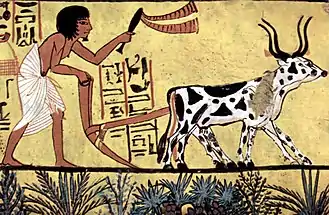Agricultural technology
Agricultural technology or agrotechnology (abbreviated agritech, AgriTech, or agrotech) is the use of technology in agriculture, horticulture, and aquaculture with the aim of improving yield, efficiency, and profitability. Agricultural technology can be products, services or applications derived from agriculture that improve various input/output processes.[1][2]
| Agriculture |
|---|
 |
|
|
Advances in agricultural science, agronomy, and agricultural engineering have lead to applied developments in agricultural technology.[3][4]
History
The history of agriculture has been shaped by technology advances. Historians have described a number of agricultural revolutions, which identify major shifts in agricultural practice and productivity. These revolutions have been closely connected to technological improvements.
A major turning point for agricultural technology is the Industrial Revolution, which introduced agricultural machinery to mechanise the labour of agriculture, greatly increasing farm worker productivity. In modern mechanised agriculture powered machinery has replaced many farm jobs formerly carried out by manual labour or by working animals such as oxen, horses and mules.
Advances in the 19th Century included the development of modern weather forecasting. Improvement to portable engines and threshing machines lead to their widespread adoption.
The 20th century saw major advances in agricultural technologies, including the development of synthetic fertilizers and pesticides, and new agricultural machinery including mass produced tractors and agricultural aircraft for aerial application of pesticides. More recent advances have included agricultural plastics, genetically modified crops, and soilless farming techniques such as hydroponics, aquaponics, and aeroponics.
In the first decades of the 21st century, Information Age technologies have been increasingly applied to agriculture. Agricultural robots, agricultural drones and driverless tractors have found regular use on farms, while digital agriculture and precision agriculture make use of extensive data collection and computation to improve farm efficiency.[5]
Types of agricultural technology
Technologies and applications in agricultural technology include:
- Agricultural drone
- Satellite photography and sensors
- IoT-based sensor networks
- Phase tracking
- Weather forecasts
- Automated irrigation
- Light and heat control
- Intelligent software analysis for pest and disease prediction, soil management and other involved analytical tasks
- Biotech
Agricultural drones
Drones can be used for scanning crop fields with compact multispectral imaging sensors, GPS map creation, heavy payload transportation, and livestock monitoring with thermal-imaging cameras.
High-income countries have seen recent improvements in their agricultural management systems through modern remote sensing technology such as satellites and aircraft and the information they collect. The vast amount of data collected through this technology can provide useful for farmers and fishers. This has led to better crop yields, higher quality produce and more sustainable agricultural practices. Big data also informs high-level decision-makers on how to better manage food supply at national and regional levels.
The use of small Unmanned Aerial Vehicles (UAVs), better known as 'drones' for agricultural purposes, is a new emerging technology which could revolutionise the way agricultural entrepreneurs interact with their land, water, crops and infrastructure. UAVs can be made specifically for business use and farming; in particular, they can capture geo-referenced, overlapping, high-resolution images (2–5 cm) of 400 hectares in a single flight; can seamlessly upload data and produce agricultural analytics from their data management systems and can fly autonomously from take-off to landing.
Hydroponics technology
Hydroponics is a soilless farming technology that is used to grow vegetables and tomatoes.
It guarantees an all-year-round production for farmers and insulates these crops from the effects of climate change.
See also
References
- "Agriculture Technology | National Institute of Food and Agriculture". nifa.usda.gov. Retrieved 2020-12-23.
- "Agricultural technology". Encyclopedia Britannica. Retrieved 2020-12-23.
- "Agricultural Technology Center > Agricultural Technology Center". english.busan.go.kr. Retrieved 2020-12-23.
- "The evolution of agricultural technology". Innovation News Network. 2020-07-08. Retrieved 2020-12-23.
- "Agricultural Technology - an overview | ScienceDirect Topics". www.sciencedirect.com. Retrieved 2020-12-23.